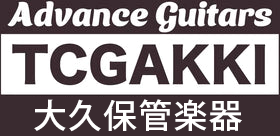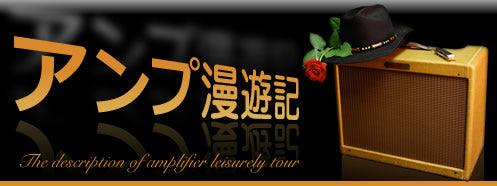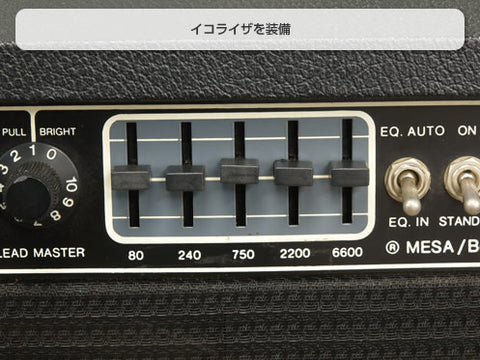
What guitar amps follow in the footsteps of Marshall and Fender? Mesa/Boogie is probably the name that most people would mention. The MK series, with its first-class tone that transcended genres from Santana to Metallica, and the Rectifier series, which later came to describe the sound of modern heavy amps, are examples of the highly original and high-quality sound of Mesa Boogie amps. The MK series, with its first-class tones that transcended genres and were loved by people all over the world, and the Rectifier series, which has since come to define the sound of modern heavy music, are some of the best brands in the United States. The brand's uncompromising commitment to playability and sound quality, including the design of power amplifiers with a unique output structure known as "SimulClass," led to the creation of numerous one-of-a-kind models. In addition, they were the first to produce a 2-channel model with a clean/drive switch, which is said to be the first of its kind in the world. In this article, we will trace the history of Mesa/Boogie, focusing especially on the early MK series, and examine the uniqueness of its design.
It all started with the Fender Princeton
Randall Smith, founder of Mesa/Boogie and designer of Mesa/Boogie amplifiers, began repairing and modifying amplifiers in the late 1960's. Born in San Francisco in the 1940's, his father was a clarinet player, and from an early age he became familiar with the sound of instruments, especially woodwinds. He was familiar with the sound of musical instruments, especially woodwinds, from an early age. As a young boy, he became interested in the cutting-edge vacuum tube audio circuitry of the day, and enjoyed building radios and other devices in a garage store owned by a neighborhood engineer. Thus, Randall Smith grew up with the sound of quality instruments and excellent engineering.

In the 1960s, during the heyday of rock and roll music, Fender had already become a major player in American music with its blackface amplifiers, and Marshall amplifiers were being developed in England. However, the role of the electric guitar in the music scene at that time was still the rhythm part, and most of the solo parts between songs were occupied by saxophones and other wind instruments. Many guitar players of the time wanted to be the center of lead playing, but suffered from a lack of sufficient gain and sustain. Fender amps, which were the mainstream at the time, were powerful for chord work, but it was difficult to get the extended, singing tone of a wind instrument, and Marshalls were not yet widely available in the United States. For this reason, master volume modifications were made to Fender amps, but it was still difficult to obtain a good lead tone.
In such a scene, Randall Smith, who was still in high school, naturally fell in love with rock 'n' roll. He played as a drummer (coincidentally, the same as Jim Marshall), but by this time he had already developed considerable engineering skills and was repairing amps for his bandmates. Eventually his repair skills became so well known that he and a friend opened a repair store in the San Francisco Bay Area. His store became a local sensation, and many musicians, including Jefferson Airplane and the Doobie Brothers, began to show up.
One day in 1969, out of mischievous curiosity, he decided that it would be fun to get an incredibly loud sound out of a small practice amp, so he installed a Fender Princeton amp with a large transformer and two 6L6 power tubes in it and built a Bassman circuit. A Bassman circuit with a large transformer and two 6L6 power tubes was built into the Fender Princeton amp. The baffle board was replaced and JBL 12-inch speakers were used for the speakers (the original baffle board that was removed was used for the doors of the workshop at the time, which was called Dog Yard). A customer happened to pass by, played it and said, "Shit man, that little things really Boogies ! This was the origin of the name "Boogie. The customer was Carlos Santana, who at that time was a big name in the music business.
Thanks to Santana, the Boogie/Princeton attracted a lot of attention, and Randall was inundated with orders for a considerable number of them. Randall built about 150 to 200 of the Boogie/Princeton, but because it was based on an old Fender amp, the supply was limited, and it became difficult to keep up with the ever-increasing number of requests. Randall therefore founded a company called Mesa Engineering and began to develop and manufacture original amplifiers. (The name Mesa was an idea that came to Randall from his side job as a handyman who needed a name for his car repair business...) ) Anyway, the first original amplifier was the Mesa/Boogie (like the Sony Walkman), of which about 3,000 units were produced. This is what we call MK-I in the later period.
The first lead guitar amp?
This is how the MK-I appeared in 1972. One more pre-tube was added to the Princeton/Boogie model, which allowed for even more gain sustain; three volume configurations, Volume 1, Volume 2, and Master, provided a wide range of gain control. It is said to be the first model in the world to be equipped with a volume for gain increase. Even Marshall did not come out with a master until 1975, so it is not difficult to imagine how early this was. The 12-inch speaker was built into an enclosure made of koa, maple, and other luxurious hardwoods, giving it the appearance of a high-end musical instrument, something that had never existed in guitar amplifiers up to that time. The singing tone and rich wood sound may have reminded Randall of the sound of the clarinet, which he had been familiar with since he was a child. It goes without saying that this was Carlos Santana's heyday, but with the rise of hard rock and the crossover movement, the lead guitar was becoming more and more central to the music scene. In Japan, many lead guitar players, such as Masayoshi Takanaka, were captivated by the extended tone of this model, and it went on to establish a worldwide reputation.


Note: The MK-I reissue model was discontinued at the end of August 2008.
In 1979, the MK-II with lead/rhythm switching function appeared. (Conversely, with the introduction of the MK-II, the earlier Mesa/Boogie models became known as the MK-I.) Channel switching at this time was revolutionary and had not yet been realized by either Marshall or Fender. From a global perspective, it is difficult to say which was earlier, Japan's Yamaha F series or the F-Series, but it is probably the world's first for a tube amp. The following year, in 1980, the MK-IIB was introduced with the world's first effects loop and simul-classes. This was a unique operation method that mixed Class A and Class AB power tube operation and succeeded in bringing out the best of both. This feature became Mesa/Boogie's exclusive patent, and is still used in the MK series to this day. Then in 1983, the MK-IIC was introduced with a switchable effects loop. As can be seen, Mesa/Boogie has a stronger image of a later era than Marshall or Fender, but it is true that Mesa/Boogie started somewhat later, but they were ahead of other brands in developing a succession of functions that would become the foundation of later eras, indicating that they were an extremely cutting-edge manufacturer. The MK-II model also had a high-gain tone that seemed to anticipate the times, and was used not only by fusion players, but also by heavy music scenes such as Metallica, and it can be said that it became the foundation for the later conception of high-gain = Boogie. In fact, in the heavy metal scene from the mid-1980s, either a modified Marshall or a stack of MK-IIIs with iron-plated cabinets became the trademark.



Let's take a break for a moment - what is it that we often hear about Class A and Class AB?
What do these terms, which you often see in amp specs, stand for? They represent the operating state of the power tubes. Power tubes are vacuum tubes that amplify the signal from the preamplifier to a level that can be heard through speakers, but there are many factors that contribute to their stable operation, and their operating conditions vary.
To explain this in a simple diagram, an audio signal is a waveform, which looks like the following.

Class A refers to the operation in which all vacuum tubes are amplifying this signal (regardless of whether there is an input or not) while being driven at any time. Since each vacuum tube is always in full drive and is operating at full open before the input signal is received, the response to the input signal is excellent, and nuances such as touch are reflected with acute sensitivity, resulting in a richly expressive tone. On the other hand, since the vacuum tube is always running at full power, it generates a lot of heat and clips quickly, making it unsuitable for large outputs. For the same reason, the tubes also have the disadvantage of having a short life span.
To solve this problem, the Class B operating method was invented, which first divides the waveform in the above figure into two parts from the center.

If one tube amplifies the upper side and the other tube amplifies the lower side, the workload of each tube is halved, and this operation is called push-pull. In addition, in contrast to Class A, where the tubes are fully driven even before a signal is input, Class B has the added function of a bias current flowing when a signal is input and the tubes resting when there is no signal, thus greatly increasing the life of the tubes.
However, Class B was not suitable for acoustics because of its poor response due to the vacuum tube starting up after the signal is input, poor reproducibility for small signals, even at high volumes, and noise. Class AB is a push-pull operation with a slight bias current added as needed to improve response. The Class AB is a Class B with a slight Class A role, and most of Marshall and recent Fender models use this method.
The SimulClass, which appears in Mesa/Boogie's MK series, is a mix of four power tubes, two of which output 60 watts of Class AB and the other two output 15 watts of Class A. This allows for a good blend of the attractive elements of both the rich response of Class A and the high-power output of Class AB. This method successfully blends the attractive elements of both Class A and Class AB. In addition to the 6L6 power tubes normally used for Class A operation, EL34 power tubes can also be used for a slightly European sound.
As mentioned above, the maximum output power and tube life are not as good as those of Class AB. For this reason, 60/100W models with Class AB output are also manufactured at the same time.
About Class A
There is some debate in the audio world and elsewhere as to what constitutes pure Class A operation, and some believe that amplifiers that operate strictly in Class A are almost non-existent. AB" or "Class A-like Class AB".
MK-III ~ MK-IV
Returning to the history of the MK series, the MK-III, the most major of the MK series, was introduced in 1986. The MK-III was a three-channel model that included a clipped "Rhythm 2" channel in addition to the two conventional lead/rhythm channels, which was too radical at a time when even two-channel switching was a novelty. The standard model was a 6L6x2 60W, with four power tubes for simul-classes and 60/100W options, and foot-switchable EQ and reverb were also available as options. While the traditional hardwood exterior was available, the EX cabinet, with its black iron grille and hardened image, became the face of the 80's hard scene along with Marshall.
|
|
|
|
|
|
|
|
|
|
|
|
|
In 1989, the MK-IV with three independent channels was introduced. The MK-IV is equipped with six footswitches that allow switching between three independent channels (clean, crunch, and lead), EQ, and effects loop, and can also be operated from other switchers using external controls. In addition to the well-known Class A/Simultaneous switching, the model also has a triode/pentode selector and a recording out that can mute the power amp. Although these features are now mainstream, it is amazing to think of the foresight that went into equipping this model with these features nearly 20 years ago. This MK-IV is still in production and available new. Note: The MK-IV is no longer in production as of the end of August 2008. |
|
|
|
|
|
|
|
|
|
|
|
|
|
|
I think there are many people who have played the MK-III before. When talking with such people, I sometimes hear them say, "MK-III has good distortion, but its clean sound is not so good..." In fact, until a certain point in my life, I had been playing the MK-III. In fact, I used to think so myself until a certain point in my life. However, one day I had the opportunity to play a brand-new MK-III with brand-new American tubes, and the impact was so strong that it was ranked among the "top three cleanest I have ever heard. (The next two were Callaham's EL84V and Fender's Tweed Twin). The overtones were beautifully three-dimensional, coming from all directions, and the afterglow of that moment is still burned into my memory, as if this was what the "bell-ringing" sound was all about.
For the reasons I have explained, the Mesa/Boogie MK series is designed to express the tone of the vacuum tubes more straightforwardly, and for this reason, the sound is exceptional when good quality vacuum tubes are used. However, for the same reason, not all tubes are in perfect condition, as they wear out more quickly than other models. Because the MK series is more honest about the sound of the tubes, it has the honesty to produce the sound as it is when the tubes are worn out. (To put it bluntly, Marshall and others have the ability to produce a "Marshall sound" even with a reasonable tube, and I think this is one of Marshall's great qualities...)
If you own an MK series guitar and have any doubts about its clean tone, we recommend that you try replacing the power tubes. Also, if you see them in a studio, it would be fun to look at the backs of the 60W, 60/100W, or Simul (it says "Simul Class" on the back), as the sound is quite different for each.

We are also looking forward to receiving your comments and suggestions on what you would like to see featured in this amp ramble. We are still in the process of learning, but we would like to respond to you as much as we can (and expand on that).








